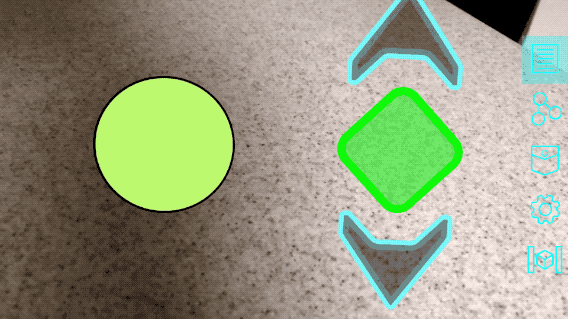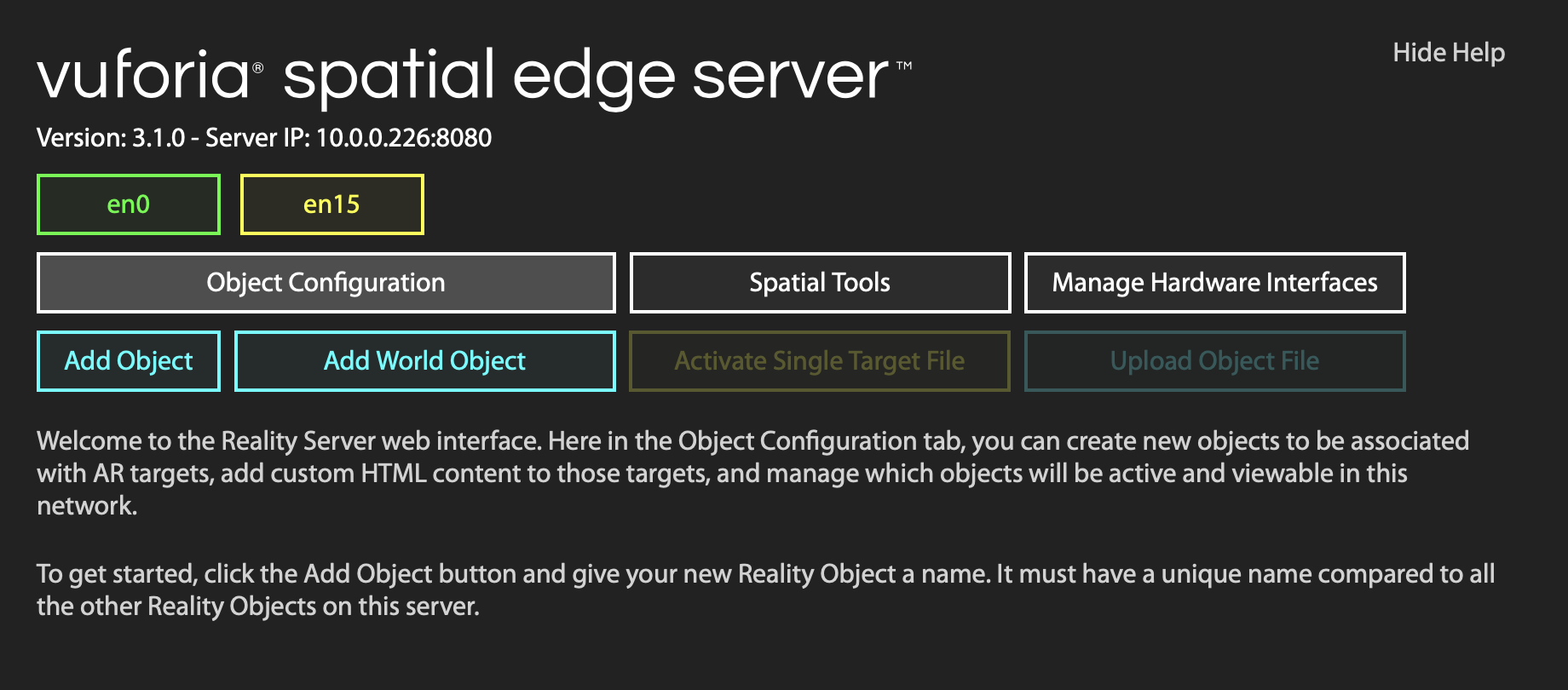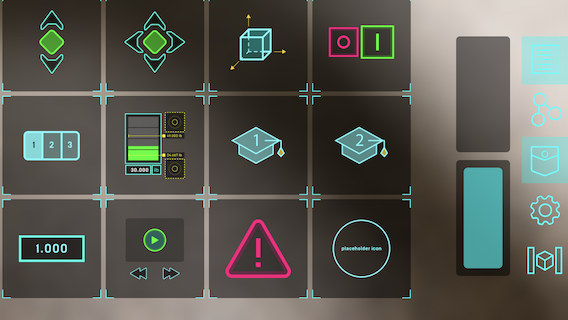Creating a Simple Tool
In this tutorial, you will learn how to build a tool that can be placed in space and change color in response to other tools:

You will learn to create a global tool, which means this tool will appear in your pocket so you can add as many of them to the scene as you want. A follow-up tutorial will show you how to create this as a local tool instead.
Setting up a new addon
The tools that appear in your pocket come from the addons of any edge servers in your network (including the one on the phone). So to create a new tool, lets create a new addon to hold your experiments. If you already have an addon, feel free to add this to that one.
First, navigate to your vuforia-spatial-edge-server/addons directory. If you don’t already have
a Vuforia Spatial Edge Server installed, refer to the installation instructions
here before you continue.
In that directory, you will likely see the vuforia-spatial-core-addon, but rather than add our
new tool to the core-addon, create a new directory next to it called my-addon. Inside my-addon,
create a new directory called tools. This will hold all of the new tools you develop that will
get added to this edge server.
Create the index.html file
Now, within the tools directory create a directory with the name of the tool you want to create,
which in this case will be called randomColor. Finally, inside that directory create a new HTML
file called index.html. The resulting path of that file should be
vuforia-spatial-edge-server/addons/my-addon/tools/randomColor/index.html.
The resulting directories should look like:

Edit the index.html file and replace its contents with the following. I’ll explain each comment (1–4) afterwards.
<!DOCTYPE html>
<html lang="en">
<head>
<!-- 1. these libraries will be injected by the Edge Server -->
<script src="objectDefaultFiles/object.js"></script>
<script src="objectDefaultFiles/pep.min.js"></script>
<meta charset="UTF-8">
<title>randomColor</title>
<style>
/* Fill the page with a circle */
#container {
/* (290 + border) will fit inside body size */
width: 290px;
height: 290px;
border: 5px solid black;
border-radius: 50%;
}
</style>
</head>
<!-- 2. Set the width and height of your tool here -->
<body style="width: 300px; height: 300px">
<div id="container"></div>
<script>
// 3. Try to load the SpatialInterface APIs.
let spatialInterface = new SpatialInterface();
// 4. When we tap on the container, change the color
let container = document.getElementById('container');
container.addEventListener('pointerup', function() {
let newHue = Math.round(Math.random() * 255);
setColor(newHue);
});
function setColor(hue) {
container.style.backgroundColor = 'hsl(' + hue + ', 90%, 70%)';
}
</script>
</body>
</html>
- The
object.jsfile contains all of the APIs that let this HTML page function in AR in the Vuforia Spatial Toolbox app. When the server loads this tool as an addon, it will inject that script at the pathobjectDefaultFiles/object.js. (The second script, pep.min.js, lets us use pointer events even if the app is running an old browser version). - The width and height of the body will define the size of the tool. Any HTML contents outside of the width and height will be cropped.
- Because we have included the
object.jsscript, we can access the APIs it provides by creating a new SpatialInterface instance. We aren’t using it for anything yet (we will by the end of this tutorial), but you should instantiate it anyways so that the tool properly loads. - Here we can add any behavior to this tool, as if it were an ordinary HTML page. We add a pointerup event so that if the user taps on the tool, it will pick a random color and change its background to that. Note that we have to use pointerevents (pointerup, pointerdown, pointermove, and pointercancel) – regular mouse or click events won’t work.
Create the icon.gif file
You then have to give your tool an icon image, which is what it will look like in the pocket. For now, download and use this placeholder image:
![]()
Place it in the same directory as the index.html file. Make sure it is named icon.gif.
Ensure your server is set up correctly
If your server doesn’t have a world object yet, you won’t see this tool in your app. Why does it need a world object? This global tool that you built only exists on this edge server, so it only knows how to “stick” to objects on this edge server. Creating a world object on this server sort of “blankets” your space with an invisible object that your custom tools will know how to attach to.
To add a world object to your server, run your server (node index.js in the terminal in your
vuforia-spatial-edge-server directory), and then visit http://localhost:8080 in a web browser.
If you’ve added objects before, you’ll see them listed. If you haven’t it’ll be empty and look
something like this:

Now click on the “Add World Object” button and type in a name, such as “test”:

Click the big green “Add” button and you’ll see your new world object pop up. Like with regular objects, it’ll begin in an inactive state, and you’ll have to attach a target to it to activate it.

You can refer to this tutorial for how to attach different types of target data to your object. I used one of the sample image targets from the Vuforia developer portal but you can use a different target if you want. When you’re done, the server interface will reload and the button on the right edge will change to “On”, you should be all set. You can ignore the other buttons for now:

We can check that your server has successfully found your tool from the addon you built by clicking on the “Spatial Tools” tab near the top center of the dashboard. This will bring you to a different view that lists all of the tools that this server can provide to clients in the network:

If you scroll down all the way, you should see an entry for your randomColor tool:

If you don’t see this, try restarting your server. If you still don’t see it, go back to the steps on setting up your addon to make sure everything is in the right place.
Now that you have your world object set up, and you’ve verified that your server knows about the tool that you built, you should see the tool icon in the pocket of you app if you’re connected to the same WiFi network as the computer running the edge server. (Scroll down to the bottom row of the pocket)

If you tap on the placeholder icon in the pocket, it will add an instance of your tool to the scene. Tapping on it will randomly change its color.

Ta-da! You’ve just built your first tool! You can add as many of these to your scene as you want.
Make it programmable
Right now, if you switch to programming mode in the app, you won’t be able to link this tool to any other tools, because we haven’t created a node for the tool in the index.html file. Let’s change that.
Replace the contents of index.html with the following. I’ll explain each new comment (5–7) afterwards.
<!DOCTYPE html>
<html lang="en">
<head>
<!-- 1. these libraries will be injected by the Edge Server -->
<script src="objectDefaultFiles/object.js"></script>
<script src="objectDefaultFiles/pep.min.js"></script>
<meta charset="UTF-8">
<title>randomColor</title>
<style>
/* Fill the page with a circle */
#container {
/* (290 + border) will fit inside body size */
width: 290px;
height: 290px;
border: 5px solid black;
border-radius: 50%;
}
</style>
</head>
<!-- 2. Set the width and height of your tool here -->
<body style="width: 300px; height: 300px">
<div id="container"></div>
<script>
// 3. Try to load the SpatialInterface APIs.
let spatialInterface = new SpatialInterface();
// 5. This attaches a programmable node to your tool
spatialInterface.initNode('hue', 'node', 0, 0);
// 6. Whenever data arrives at the node, update the color of this tool
spatialInterface.addReadListener('hue', function(event) {
let newHue = Math.round(event.value * 255);
setColor(newHue);
});
// 4. When we tap on the container, change the color
let container = document.getElementById('container');
container.addEventListener('pointerup', function() {
let newHue = Math.round(Math.random() * 255);
setColor(newHue);
// 7. Whenever we tap, emit the new hue from the node
spatialInterface.write('hue', newHue/255);
});
function setColor(hue) {
container.style.backgroundColor = 'hsl(' + hue + ', 90%, 70%)';
}
</script>
</body>
</html>
- As soon as the tool loads, we initialize a new programming node that will be attached to the tool. Its name will be “hue” (to represent the color of the tool), and it will be a default node type (“node”). It will be positioned at the center of the tool (x=0, y=0).
- This is how we can listen to data being sent to this node from another node in the system. The
event.valuewill be the data sent to it, in the form of a number between 0 and 1. We need to scale that up to the range [0,255] because the setColor function expects a value in that range. Whenever another node sends data to the hue node, this will trigger and update the color. - This is how we can output data from the hue node and send it to other nodes that this links to. We need to scale the newHue down by a factor of 255, because it is currently in the range of [0,255] but all data sent across links should be in the range [0,1]. In this way, when we tap on the tool, in addition to setting its color randomly, it will also output a random value from its node.
If you save this file and reopen your Vuforia Spatial Toolbox app, you will have an updated version of the randomColor tool in you pocket. You can now link other tools to its node to set its color programmatically, e.g:

You can also tap on the node to output a value, e.g:

Conclusion
In this tutorial, you have learned the following:
- How to create an addon for your edge server to contain a custom-built global tool.
- How to set up a starter-template for a tool, with an icon and a simple HTML page.
- How to use the Toolbox APIs to add a node to your tool, and read and write data to that node.
At this point, you can try to add more functionality to this tool, or create an entirely new tool with whatever UI you can think of. Some ideas:
- Add more nodes to this tool to control the saturation and lightness of the color, in addition to the hue.
- Instead of choosing the color randomly, set it based on (x,y) position of your pointerevent, or build a menu outside the circle that lets you select between a few chosen colors.